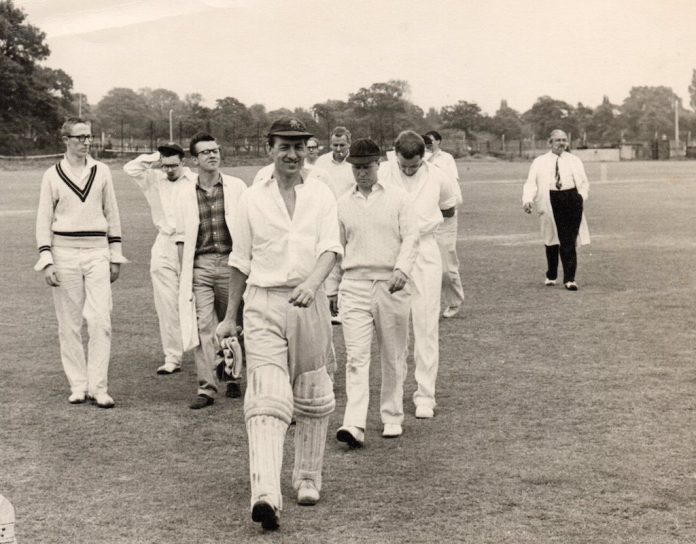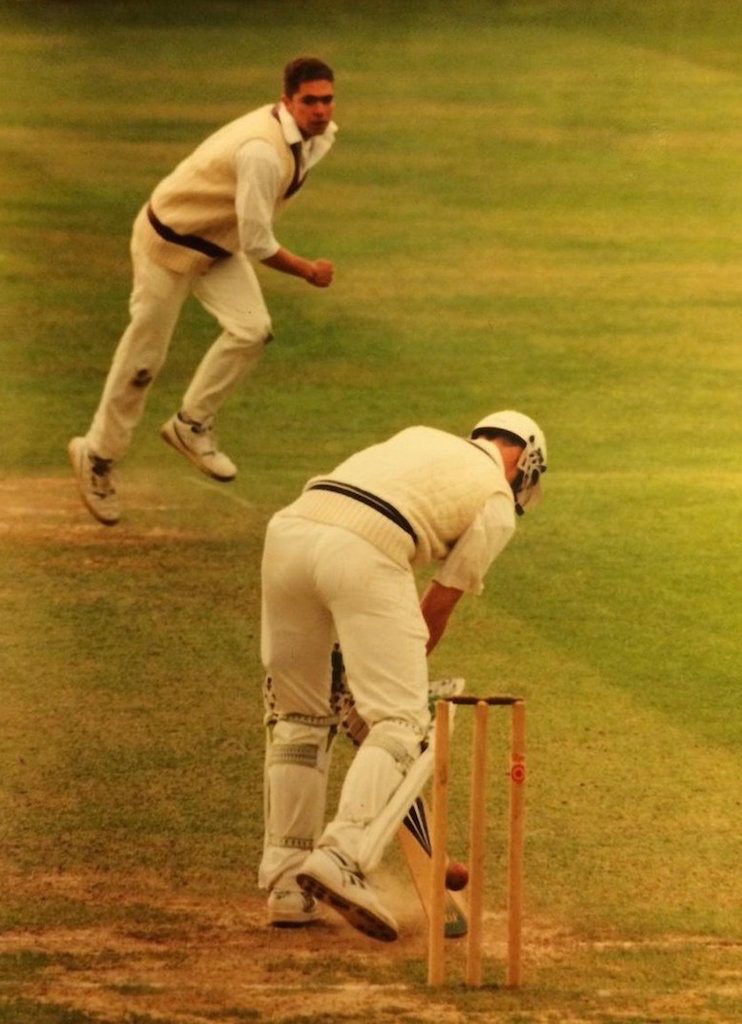
Vic Lewis’ showbiz team played against one of the more curious teams that emerged at that time – the Ravers C.C. Founded in 1954 in the Blue Posts pub, as a result of Wally Fawkes and George Webb deciding that the 100 Club (then known as the Lyttelton Club) should have a jazz cricket team, its early members included Mick Mulligan, Max Jones, Sandy Brown, Jim Bray, Harry Hayes, Monty Sunshine and agent Lyn Dutton. During the next few years Bruce Turner, Frank Parr, Frank Holder and his brother Ovid, Bob Dawbarn, Jim Godbolt and Ray Smith were all regulars. Others in the jazz fraternity that later played included Brian Lemon, John Chilton, Johnny Barnes, Campbell Burnap, Jeff Horton of the 100 Club, writer Richard Williams and Martin Ash (aka Sam Spoons of the Bonzo Dog Band).
Brian Statham of Frank Parr: ‘…a fine wicketkeeper, but he was an arty, untidy type who looked what he was, a spare-time musician’
Frank Parr was the most eminent cricketer, having played for Lancashire from 1951-54 and tipped by the Times as a potential future England wicket keeper. Unfortunately he fell out with the Lancashire captain, Cyril Washbrook, and although Frank was offered a place at Worcestershire, Washbrook told them Frank was something of a social liability, apparently based on his scruffiness and habit of holding jam sessions in the changing room. The Lancashire and England fast bowler, Brian Statham, described Frank as “a fine wicketkeeper, but he was an arty, untidy type who looked what he was, a spare-time musician. Even in flannels, walking on to the field, he still managed to look anything but a cricketer”. A trombonist with the Merseysippi Jazz Band from 1949, Frank gave up county cricket and joined Mick Mulligan’s Magnolia Jazz Band in 1956, depicted graphically in George Melly’s Owning Up.

The team had its share of eccentrics – when captain Lyn Dutton asked Bruce Turner to field at square leg, the saxophonist was reluctant and when pressed for a reason answered “Don’t like going anywhere that’s square, Dad”. Melody Maker photographer Eric Jelly often baffled opposing batsmen, as when fielding, the ball would make a deafening clank that resounded around the ground after hitting his tin leg.
Drummer and manager of Collets Jazz Shop (later Ray’s), Ray Smith, was a long-serving member of the team. As a “modernist” amongst many traddies and mainstream jazzers, Ray took some flak, especially on his debut when the caustic Mick Mulligan started singing “I Ain’t Got No Body” on seeing Ray’s unathletic, skeletal body in the changing room. But Ray was a spin bowler of great skill, taking over 1,000 wickets and such was his reputation that a rival club invited him on tour. In one match, Ray took all nine wickets to fall when the last batsman came in. It was the last ball of his over and he decided to improvise – change his style by bowling absolutely straight, simply varying the pace and flight. This had the desired effect as the final batsman missed the ball which hit his pad directly in front of the stumps. A clear leg before wicket and all 10 wickets for Ray. To his astonishment the umpire judged it not out. The bowler at the other end then took the tenth wicket. In the club house after the match, over a drink, Ray questioned the decision and the umpire agreed it was plumb lbw, but added that as the batsman in question was chairman of the club, he had no intention of giving him out first ball. Enough said!
Later, in the early 80s, this ability and prowess led to Ray being asked to advise young spin bowlers at the nets at Lords, where he could often be seen watching matches with drummer Charlie Watts, another ardent follower of the game, or with his close friend, improvising musician Paul Shearsmith. In his earlier drumming days, Ray was in Wally Fawkes’ band that also had Dave Wilkins on trumpet, so one can imagine the conversation in the band room.
There are many other examples of jazz musicians being involved with the sport. When Jim Laker famously took 19 wickets in the test against Australia at Old Trafford in 1956, Tubby Hayes dedicated a number, Laker’s Day, in recognition of the performance. Recorded as Live At The Flamingo at the Railway Arms, West Hampstead, the band shouts “Howzat!” at the end of the number. Tony Hall, who co-produced and introduced the session, later wrote in his column Hall Hears in the Record Mirror, August 1957, that “many modernists are ardent cricket enthusiasts” and referred to Hayes spending most of his free time at the Oval cricket ground. Also mentioned was a Tubby Hayes XI which played against a team organised by drummer Terry Seymour on Clapham Common. Participants included Allen Ganley, Phil Bates, Joe Temperley, Phil Seamen and Joe Harriott. The game was helped somewhat, Hall suggested, by the proximity of the pitch to a pub. Spike Wells, who played with Tubby (Brian) Hayes in the late 60s/early 70s and was himself a member of the MCC and Sussex County Cricket Club, said: “I knew Tubby liked cricket – we watched a programme about Gary Sobers together and, when he died, Liz (Grunlund) gave me a dog-eared copy of Testing Time For England signed, by its author, “To Brian. Best wishes Denis Compton”.
For many years The Outswingers, a band formed by saxophonist Johnny Barnes and including over the years American tenor player Spike Robinson (a member at Essex C.C.C.) and trombonists Campbell Burnap and Roy Williams, have regularly entertained the crowd at Lords during Test matches.

According to his website, bassist Orlando le Fleming’s “facility as an improviser and capacity as a team player were honed not on the bandstand, nor in the practice room, but on the cricket pitch”, when he was a professional cricketer for Devon and Somerset. Since moving to New York in 2003, he has played with Jimmy Cobb, Billy Cobham, Branford Marsalis and others.
The numerous other links range from simply using clubhouses as jazz venues (some of my earliest recollections of both were at Didsbury cricket ground) to a set of improvisational performances by British musicians in Berlin, October 2011, entitled Just Not Cricket, featuring Lol Coxhill, Trevor Watts, Steve Beresford, John Edwards, Gail Brand, Shabaka Hutchings and others. South African bassist Harry Miller could often be heard at rehearsals and gigs discussing the latest test scores with saxophonist Elton Dean. But perhaps the most curious is Canadian percussionist Chris Corsano’s CD The Young Cricketer (2006) which includes tracks such as “How should you pick up the ball and throw it”, although it has no apparent connection to the sport.
These different approaches to improvised music might be seen as mirroring those in cricket. In April 2013, Guardian sports columnist Barney Ronay compared West Indian Chris Gayle’s high-speed hundred off 30 balls for the Royal Challengers Bangalore with Billy Godleman’s painstaking half century off 244 balls for Derbyshire in the same month. He saw a clash of tempo, textures and interpretation parallel to the violent airing of differences between traditional jazz fans and modernists, followers of the bebop of Charlie Parker, during the Beaulieu Jazz Festival of 1960, but optimistically saw it as the indication of a new golden age of cricket and the meeting of “the be-bop fecundity of the new world and the enduring trad of the old”.
Let writer Richard Williams have the final word: “I like it when nobody, neither the participants nor the audience, knows what’s going to happen or how it’s going to turn out, which is the link between cricket and jazz”.

Thanks for help with this article are due to Val Wilmer, Howard Rye and the late Jim Godbolt – MW















